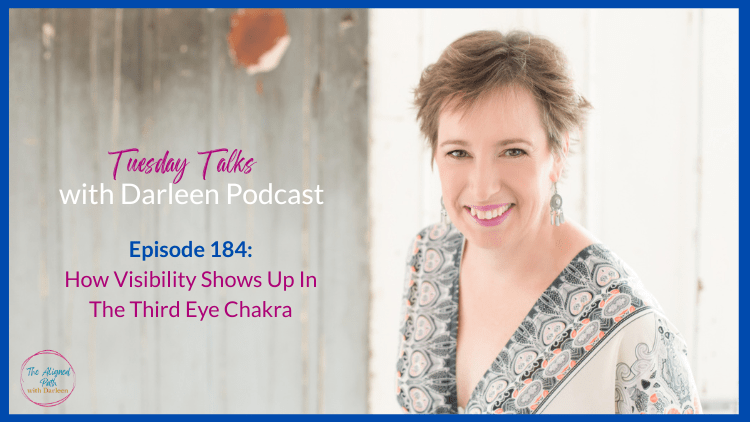Visibility isn’t limited to the physical. The Third Eye Chakra brings perception, mental clarity, and intuitive insight, and it also shapes the way visibility is received and interpreted. Energy shared through visibility can often feel exposed, raw, or easily misunderstood. So when this chakra is left without clear support or boundaries, visibility may trigger old beliefs about safety, criticism, or being “too much.”
There’s a difference between being visible and being witnessed. The Third Eye Chakra allows a person to sense the deeper energetic implications of both, and to notice when they’re aligned, and when they’re not.

EPISODE 184: Listen using the player below, or click the links to your fave platform to subscribe and listen over there:
Visibility means different things to different people
Visibility doesn’t always look like a social media post or a polished presentation. Sometimes it’s walking into a room where you used to shrink. Sometimes it’s answering honestly when someone asks how you are. Sometimes it’s sharing intuitive insight, even softly, even with uncertainty. Other times it’s more external, like hosting a group, speaking publicly, or being named as a leader. No matter the form, visibility stirs energy. And that energy lands differently depending on context, readiness, and past experiences.
The focus isn’t on what visibility looks like. It’s on how it’s felt in the body. A tight chest, shallow breath, or nervous system spike might signal it’s too much, too soon. A softening, a grounded pulse, or an ease in the voice might indicate that the space is ready. Those sensations offer guidance. Not to avoid visibility altogether, but to rebuild it in a way that honours inner rhythm, values, and truth.
Thought patterns shape perception
The Third Eye Chakra governs not only intuitive sight, but the mental landscapes that shape how visibility is interpreted. Thoughts like “I need to explain more,” or “It has to look polished,” or “They won’t understand unless I prove it” begin to crowd the channel.
These thoughts don’t always arrive as loud critiques. Often they’re subtle, absorbed through past dynamics, unspoken expectations, or spiritual communities that equated clarity with certainty. Boundaries here invite the quiet pause before reaction.
A moment to ask:
- Is this thought true, or just familiar?
- Is this urgency mine, or something I learned to carry?
The clearer the inner space becomes, the more natural expression feels. Without needing to fix the tone, control the message, or perform a version of wisdom that doesn’t align.
Practice without perfection
Visibility deepens through consistency, not through perfection. It doesn’t need to be polished or impressive to be real. What matters is returning to the space of expression with a willingness to meet whatever shows up. Some attempts will land clearly. Others may feel less defined. The value isn’t in the outcome, it’s in the presence brought to the process.
Awkwardness doesn’t mean something is wrong. Often, it’s a sign that something new is unfolding. The early stages of visibility might feel hesitant, shaky, or uneven. That’s not a flaw. It’s an honest reflection of growth taking shape in real time.
This path is supported by reminders that centre gentleness over pressure:
-
Vulnerability can accompany steadiness so both can exist in the same moment
-
Confidence often emerges slowly, through embodied repetition rather than force
-
Structural supports like notes, outlines, or intentional pauses are tools and not proof of unreadiness
When visibility is allowed to evolve without expectation, it begins to soften. It moves out of performance and into something more grounded, more relational, and more sustainable.
Creating boundaries around visibility timing
Visibility relies on more than willingness, it also asks for energetic capacity. There are times when expression feels spacious and easeful, and others when it feels like too much. Recognising this movement is part of building a visibility practice that supports rather than depletes.
Intuitive rhythms shift throughout the week or month. Some moments naturally invite outward expression. Others call for quiet, recalibration, or stillness. Creating boundaries around when and how visibility happens isn’t restrictive, it’s stabilising.
Supportive boundaries might include:
-
Scheduling visibility work within windows that feel energetically open and supported
-
Taking space after client work, group sessions, or heavy energetic output before returning to public expression
-
Making room for rest as a visible part of your rhythm, not something to hide or apologise for
When visibility is guided by energy rather than expectation, it becomes more sustainable. It holds its shape with care, not effort. And from that place, it remains connected to the truth it’s meant to carry.
Final reflections
The Third Eye Chakra offers clarity not only in what’s perceived, but in how expression is shared. Visibility that honours presence over polish doesn’t seek to impress. Instead it seeks to align. The most resonant messages don’t always arrive with force. They emerge from steadiness, from integration, from truth that’s allowed to unfold.
When expression is rooted in clarity and rhythm, visibility no longer feels like exposure. It becomes a form of connection, intentional, embodied, and real. Not louder. Not faster. Simply aligned.
Here for the links that may have been referenced in the show or is complementary to this episode.
- Podcast – Visibility In The Throat Chakra
- Podcast – Unlocking the Third Eye Chakra For Deeper Connection
- Podcast – Embracing Abundance Through The Third Eye Chakra
More in-depth content and resources:
- Blog Post – Unlocking The Magic of The 7 Main Chakras

![]()



